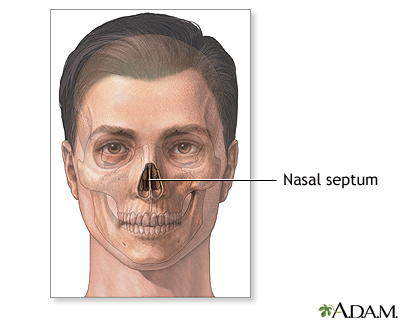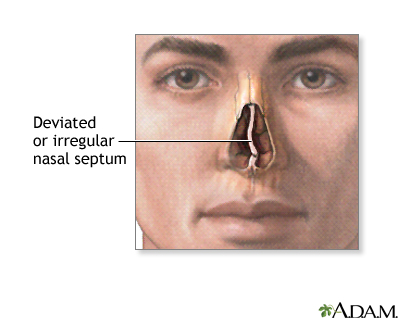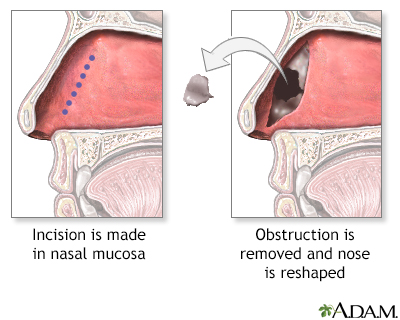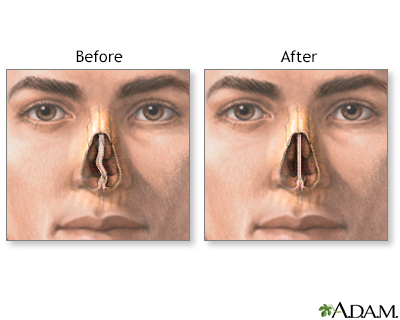Septoplasty
Nasal septum repairSeptoplasty is surgery performed to correct any problems in the nasal septum, the structure inside the nose that separates the nose into two chambers. These problems can cause the passage through the nose to be partially blocked.
Description
Most people receive general anesthesia for septoplasty. You will be asleep and pain-free. Some people have the surgery under local anesthesia, which numbs the area to block pain. You will stay awake if you have local anesthesia. Surgery takes about 1 to 1½ hours. Most people go home the same day.
General anesthesia
General anesthesia is treatment with certain medicines that puts you into a deep sleep-like state so you do not feel pain during surgery. After you ...
Read Article Now Book Mark ArticleTo do the procedure:
The surgeon makes a cut inside the wall on one side of your nose.
- The mucous membrane that covers the wall is elevated.
Mucous membrane
Mucosa is moist tissue that lines certain parts of the inside of your body. It is in your: NoseMouthLungsDigestive tractUrinary and genital tracts G...
 ImageRead Article Now Book Mark Article
ImageRead Article Now Book Mark Article - Cartilage or bone that is causing the blockage in the area is moved, repositioned or taken out.
- The mucous membrane is put back in place. The membrane will be held in place by stitches, splints, or packing material.
Why the Procedure Is Performed
The main reasons for this surgery are:
- To repair a crooked, bent, or deformed nasal septum that blocks the airway in the nose. People with this condition very often breathe through their mouth and may be more likely to get nasal or sinus infections.
- To treat nosebleeds that cannot be controlled.
Nosebleeds
A nosebleed is loss of blood from the tissue lining the nose. Bleeding most often occurs from one nostril only.
 ImageRead Article Now Book Mark Article
ImageRead Article Now Book Mark Article - To help alleviate snoring resulting from a nasal blockage.
Risks
Risks for any surgery are:
- Allergic reactions to medicines
- Breathing problems
Breathing problems
Breathing difficulty may involve:Difficult breathing Uncomfortable breathingFeeling like you are not getting enough air
 ImageRead Article Now Book Mark Article
ImageRead Article Now Book Mark Article - Heart problems
- Bleeding
Bleeding
Bleeding is the loss of blood. Bleeding may be:Inside the body (internal)Outside the body (external)Bleeding may occur:Inside the body when blood le...
 ImageRead Article Now Book Mark Article
ImageRead Article Now Book Mark Article - Infection
Risks for this surgery are:
- Return of the nasal blockage. This could require another surgery.
- Scarring.
- A perforation, or hole, in the septum.
- Changes in skin sensation.
- Unevenness in the appearance of the nose.
- Skin discoloration.
- Loss of smell or taste
Before the Procedure
Tell your surgeon or nurse if:
- You are or could be pregnant
- You are taking any medicines, including medicines, drugs, supplements, or herbs you bought without a prescription
During the week before your surgery:
- You may be asked to temporarily stop taking medicines that keep your blood from clotting. These medicines are called blood thinners. This includes over-the-counter medicines and supplements such as aspirin, ibuprofen (Advil, Motrin), naproxen (Aleve, Naprosyn), and vitamin E. Many prescription medicines are also blood thinners.
- Ask your surgeon which medicines you should still take on the day of surgery.
On the day of surgery:
- Follow instructions about when to stop eating and drinking.
- Take the medicines your surgeon told you to take with a small sip of water.
- Arrive at the hospital on time.
After the Procedure
After the procedure:
- You will most likely go home on the same day as surgery.
- After surgery, internal, soft nasal splints may be placed in both nostrils to support the septum This helps prevent nosebleeds.
- Most of the time, this packing is removed 24 to 36 hours after surgery.
- You may have swelling or drainage for a few days after the surgery.
After the surgery
Septoplasty is surgery to correct any problems in the nasal septum. The nasal septum is the wall inside the nose that separates the nostrils....
 ImageRead Article Now Book Mark Article
ImageRead Article Now Book Mark Article - You will likely have small amounts of bleeding for 24 to 48 hours after surgery.
Outlook (Prognosis)
Most septoplasty procedures are able to straighten the septum. Breathing usually improves.
References
Gillman GS, Lee SE. Septoplasty - classic and endoscopic. In: Meyers EN, Snyderman CH, eds. Operative Otolaryngology: Head and Neck Surgery. 3rd ed. Philadelphia, PA: Elsevier; 2018:chap 95.
Kridel RWH, Sturm A. The nasal septum. In: Flint PW, Francis HW, Haughey BH, et al, eds. Cummings Otolaryngology: Head and Neck Surgery. 7th ed. Philadelphia, PA: Elsevier; 2021:chap 29.
Review Date: 1/29/2025
Reviewed By: Ashutosh Kacker, MD, FACS, Professor of Clinical Otolaryngology, Weill Cornell Medical College, and Attending Otolaryngologist, New York-Presbyterian Hospital, New York, NY. Review provided by VeriMed Healthcare Network. Also reviewed by David C. Dugdale, MD, Medical Director, Brenda Conaway, Editorial Director, and the A.D.A.M. Editorial team.









